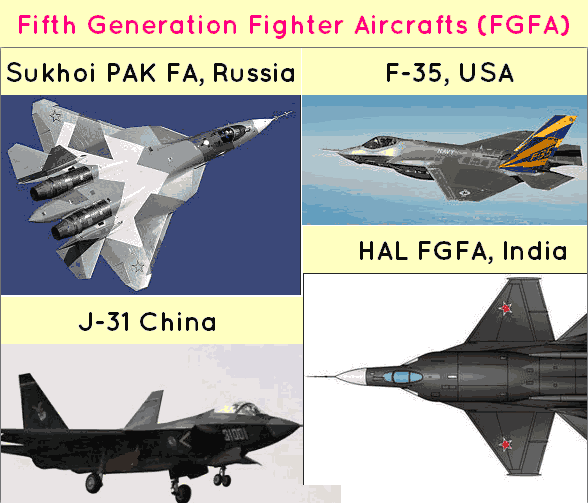- What is Fifth Generation Fighter Aircraft (FGFA)?
- Owners of Fifth Generation Fighter Aircraft (FGFA)?
- What is Shenyang J-31 (F60)?
- Implications on USA?
- Limiations of Chinese Forces
- Implications on South Asia?
- Implications on India?
- Dassault Rafale
- Sukhoi/HAL FGFA
What is Fifth Generation Fighter Aircraft (FGFA)?
- Microsoft has various generations of operating systems: Win95, XP, Vista, Win7 and Win8- Similarly aircraft too have generations.
- Fourth Generation = Those developed from 1980s onwards.
- 5th generation=2005 onwards
- 5th Generation aircraft is very hard to be detected using radars (Stealth technology).
- They carry more firepower, speed, advanced computer systems, compared to previous generations.
Owners of Fifth Generation Fighter Aircraft (FGFA)?
| USA | F-22: in service since 2005.F-35 still under development. |
| China | Still under development
It is unknown if the J-31 is meant to be a competitor to the J-20 stealth fighter or a complement to it.
|
| Russia | Sukhoi PAK FA (T-50)= Still under development. |
| India | Sukhoi/HAL FGFA= Still under development |
| Pakistan | Lolz but they might just buy F-35 using US donation money. And some reports say they’re collaborating with China in J-** project. |
What is Shenyang J-31 (F60)?
- It is the Fifth Generation Chinese Stealth Fighter jet. Currently, under development.
- Tests are successful, but it’s not combat-ready yet.
- Other nicknames: Gyrfalcon, Falcon Eagle.
- Why in News? Because in Nov. 2012, the Ex-President of India Dr.Kalam went to China.
- He was supposed to visit Aviation Industry Corporation of China (AVIC), this company is developing the J-31.
- But later, Chinese authorities canceled his visit to that company.
- Some experts believe that Chinese Government wanted to avoid exposure of J-31 to India’s top defence and aviation specialist, Dr. Kalam.
- Afterall he was closely connected with top Indian bodies like the Defence Research and Development Organisation (DRDO) and Indian Space Research Organisation (ISRO)!
Implications on USA?
- J-31 shows that China has ambitions to become the premier military power.
- US military’s performance in the 1991 Gulf War shook the Chinese army out of its Stalinist mindset, and they began modernization.
- For instance, China’s modern submarine fleet, its emerging navy, its huge ballistic missile arsenal and hundreds of modern combat aircraft = deterrent for USA.
- It doesn’t mean China could defeat USA forces in a conflict; the balance has not yet tilted quite that far, but the costs of victory for the USA would now be far higher than in the days before China’s modernisation.
- Now China can inflict a great deal of pain in such a conflict, probably more than the US would be willing to sustain to defend Taiwan or Japan.
Limiations of Chinese Forces
- China still has very little ability to project military force more than a few hundred kilometres beyond its shores. (String of Pearls not in full force yet.)
- Much of China’s indigenous military technology remains of poorer quality and performance than that of Russia or USA.
- There are of course exceptions to this judgement: China has a handful of nuclear-armed ballistic missiles with global reach, and it is developing cyber warfare capabilities that know no geographical limits.
Implications on South Asia?
- Apart from Nuclear missiles, the second most powerful weapons system for long distance deployment = an aircraft carrier.
- America has 11 super-carriers. No other nation even comes close to that kind of capability, yet.
- But If China were to deploy more than one air-craft carrier with high-performance stealth fighters like the J-31 in the neighbourhood (Indian Ocean, South China Ocean, Sea of Japan etc), then it can coerce neighbors (Japan, Vietnam India, Taiwan) in disputes, then USA would prefer not to get involved.
Implications on India?
Dassault Rafale
- In early 2012, India bought Dassault Rafale jets from France. (Cost: about $ 10 billion)
- It is a medium multi-role combat aircraft (MMRCA).
- But still it is a fourth-generation aircraft= cannot match Fifth Generation Chinese J-31 aircraft in a combat.
- Same goes for Tejas, it is fourth Generation and still under development.
Sukhoi/HAL FGFA
- This is fifth generation aircraft.
- Jointly developed by India-Russia.
- Problem: rising cost (about $30 billion), India had to cut down order from 200 to 144.
- Unlikely to be combat ready before 2020. (given Russia’s laziness, as shown in Gorshkov deal.)
Overall, $40 billion dollars stuck in above two aircraft. So, right now we don’t have any spare cash left, to buy a readymade Fifth Generation aircraft such as F-22/F-35 from USA, just to deter China.

No comments:
Post a Comment
Note: Only a member of this blog may post a comment.